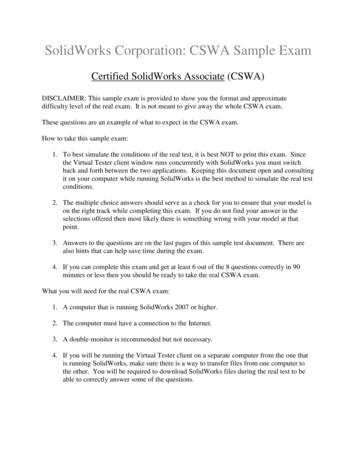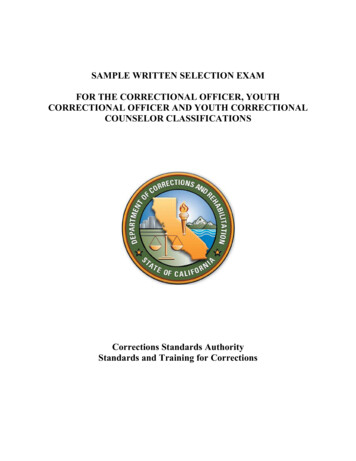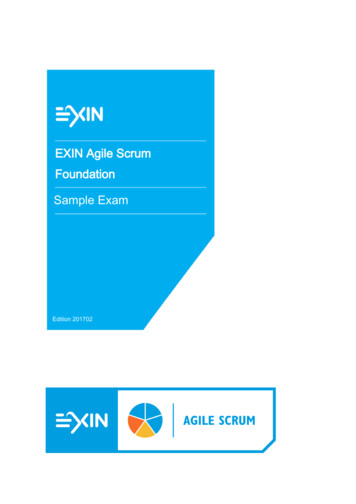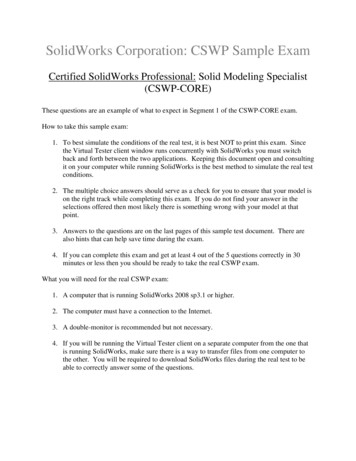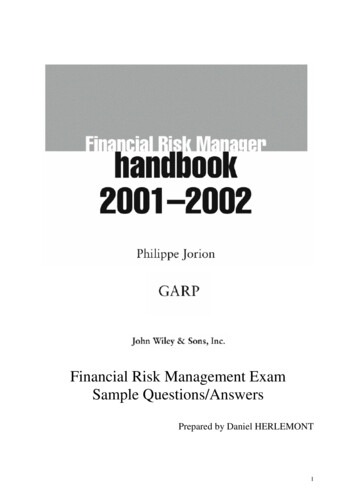
Transcription
Financial Risk Management ExamSample Questions/AnswersPrepared by Daniel HERLEMONT1
2
3
4
5
6
Chapter 3 – Fundamentals of StatisticsFRM-99, Question 4Random walk assumes that returns from one time period are statistically independent from another period. Thisimplies:A. Returns on 2 time periods can not be equal.B. Returns on 2 time periods are uncorrelated.C. Knowledge of the returns from one period does not help in predicting returns from another periodD. Both b and c.FRM-99, Question 14Suppose returns are uncorrelated over time. You are given that the volatility over 2 days is 1.2%. What is thevolatility over 20 days?A. 0.38%B. 1.2%C. 3.79%D. 12.0%σ ( R20 ) 10σ ( R10 )FRM-98, Question 77
Assume an asset price variance increases linearly with time. Suppose the expected asset price volatility for thenext 2 months is 15% (annualized), and for the 1 month that follows, the expected volatility is 35% (annualized).What is the average expected volatility over the next 3 months?A. 22%B. 24%C. 25%D. 35%σ 13 σ 12 σ 22 σ 32 0.152 0.152 0.352σσ av 13 0.236 24%3FRM-97, Question 15The standard VaR calculation for extension to multiple periods assumes that returns are serially uncorrelated. Ifprices display trend, the true VaR will be:A. the same as standard VaRB. greater than the standard VaRC. less than the standard VaRD. unable to be determinedBad Question!!!“answer” is b. Positive trend assumes positive correlation between returns, thus increasing the longer periodvariance.Correct answer is that the trend will change mean, thus d.FRM-99, Question 2Under what circumstances could the explanatory power of regression analysis be overstated?A. The explanatory variables are not correlated with one another.B. The variance of the error term decreases as the value of the dependent variable increases.C. The error term is normally distributed.D. An important explanatory variable is excluded.D. If the true regression includes a third variable z that influences both x and y, the error term will not beconditionally independent of x, which violates one of the assumptions of the OLS model. This will artificiallyincrease the explanatory power of the regression.FRM-99, Question 20What is the covariance between populations a and b:a17141213b22263129A. -6.25B. 6.50C. -3.61D. 3.61a 14, b 27a-1430-2-1b-27-5-142(a-14)(b-27)-150-8-2sum -25Cov(a,b) -25/4 -6.258
FRM-99, Question 6Daily returns on spot positions of the Euro against USD are highly correlated with returns on spot holdings ofYen against USD. This implies that:A. When Euro strengthens against USD, the yen also tends to strengthens, but returns are not necessarily equal.B. The two sets of returns tend to be almost equalC. The two sets of returns tend to be almost equal in magnitude but opposite in sign.D. None of the above.FRM-99, Question 10You want to estimate correlation between stocks in Frankfurt and Tokyo. You have prices of selected securities.How will time discrepancy bias the computed volatilities for individual stocks and correlations between thesetwo markets?A. Increased volatility with correlation unchanged.B. Lower volatility with lower correlation.C. Volatility unchanged with lower correlation.D. Volatility unchanged with correlation unchanged.The non-synchronicity of prices does not affect the volatility, but will induce some error in the correlationcoefficient across series. Intuitively, this is similar to the effect of errors in the variables, which biaseddownward the slope coefficient and the correlation.FRM-00, Question 125If the F-test shows that the set of X variables explains a significant amount of variation in the Y variable, then:A. Another linear regression model should be tried.B. A t-test should be used to test which of the individual X variables can be discarded.C. A transformation of Y should be made.D. Another test could be done using an indicator variable to test significance of the model.The F-test applies to the group of variables but does not say which one is most significant. To identify whichparticular variable is significant or not, we use a t-test and discard the variables that do not display individualsignificance.FRM-00, Question 112Positive autocorrelation of prices can be defined as:A. An upward movement in price is more likely to be followed by another upward movement in price.B. A downward movement in price is more likely to be followed by another downward movement.C. Both A and B.D. Historic prices have no correlation with future prices.FRM-00, Question 112Positive autocorrelation of prices can be defined as:A. An upward movement in price is more likely to be followed by another upward movement in price.B. A downward movement in price is more likely to be followed by another downward movement.C. Both A and B.D. Historic prices have no correlation with future prices.Answer C: both A and B9
10
11
12
13
14
15
16
17
18
19
20
21
22
23
24
25
26
27
28
29
30
31
32
33
34
35
36
37
38
39
40
41
42
43
44
45
46
47
48
49
50
51
52
53
54
55
56
57
FRM-99, Question 4 Random walk assumes that returns from one time period are statistically independent from another period. This implies: A. Returns on 2 time periods can not be equal. B. Returns on 2 time periods are uncorrelated. C. Knowledge of the returns from one period does not help i

